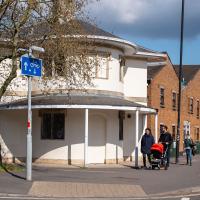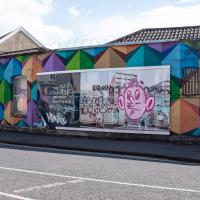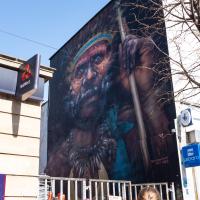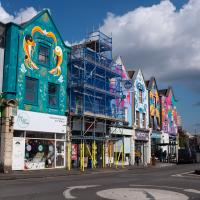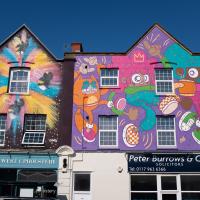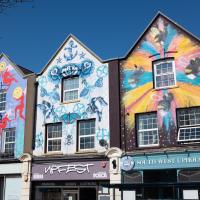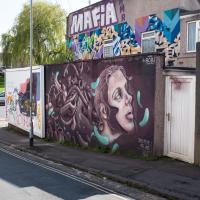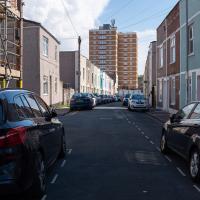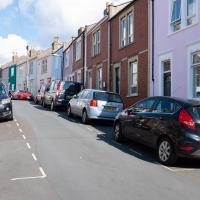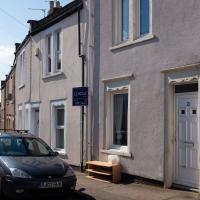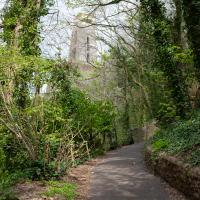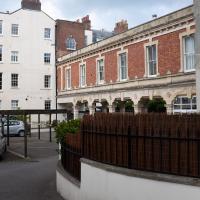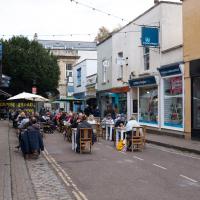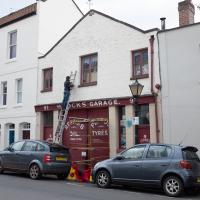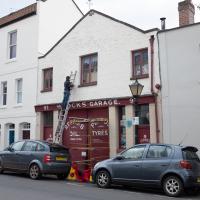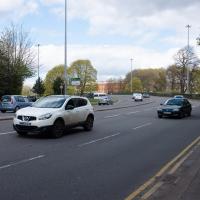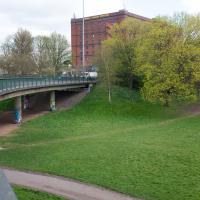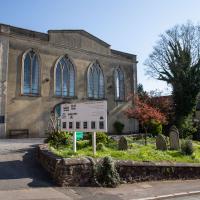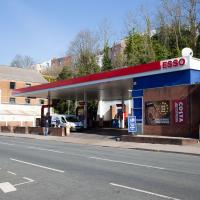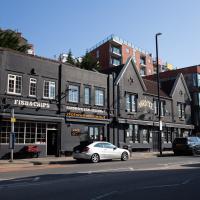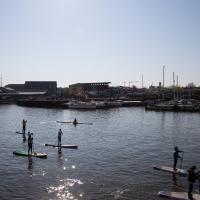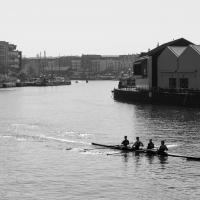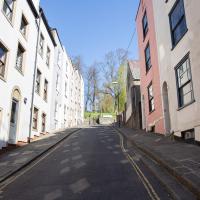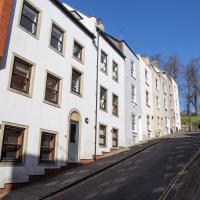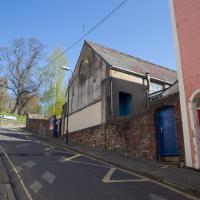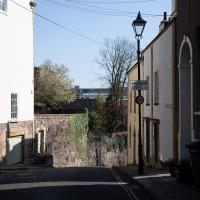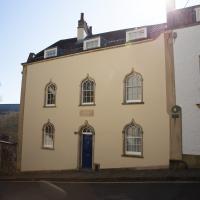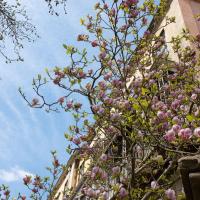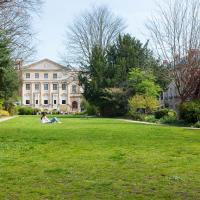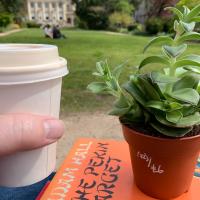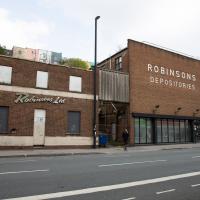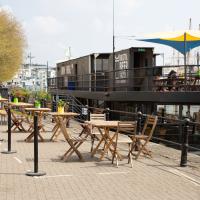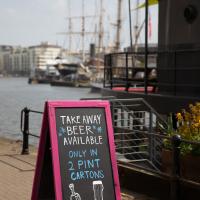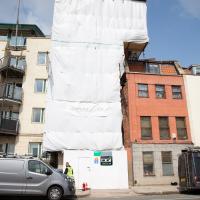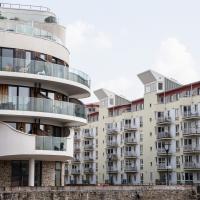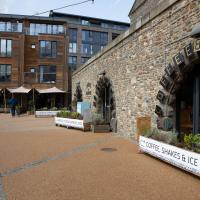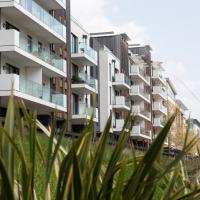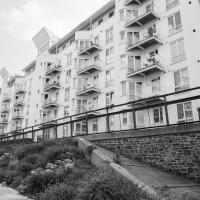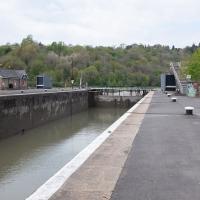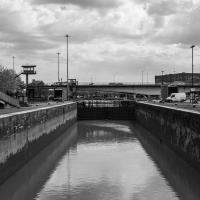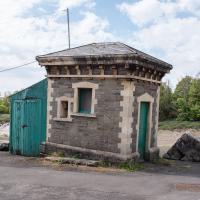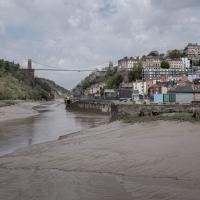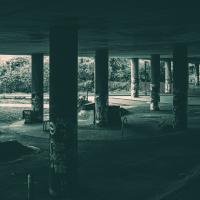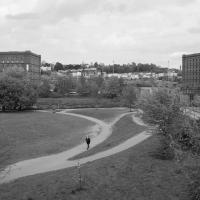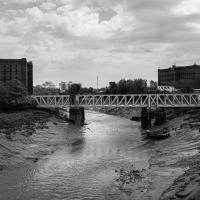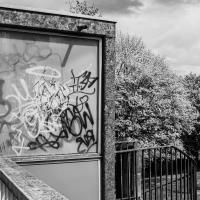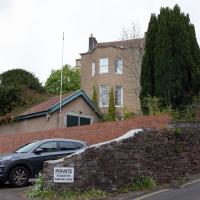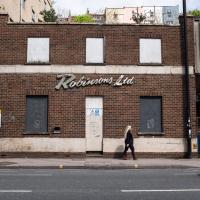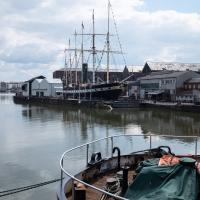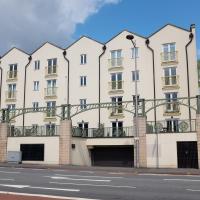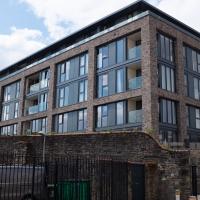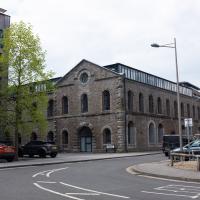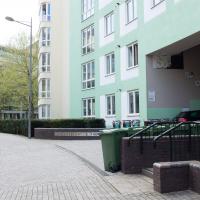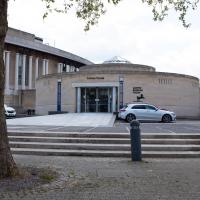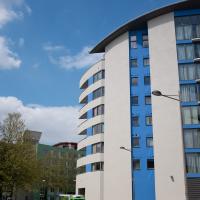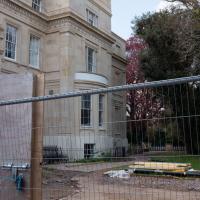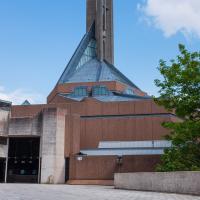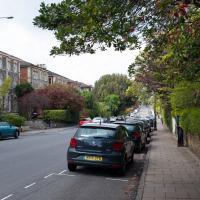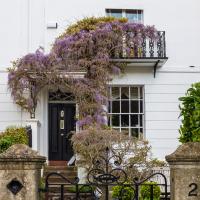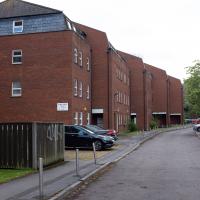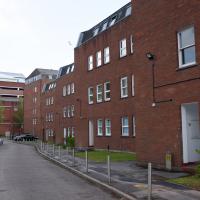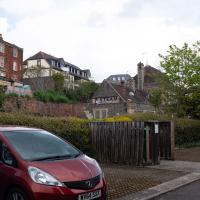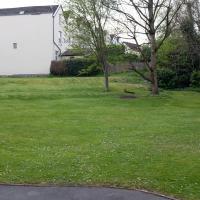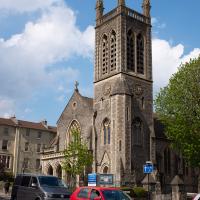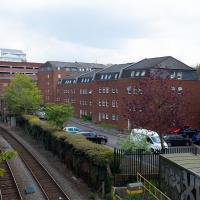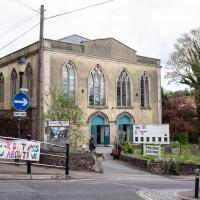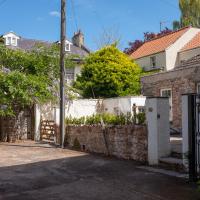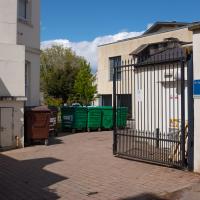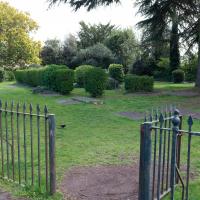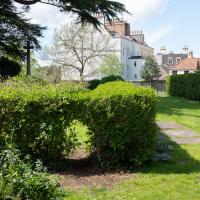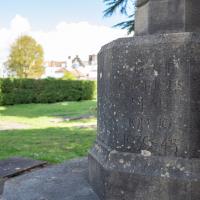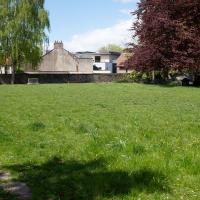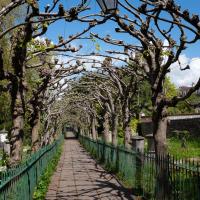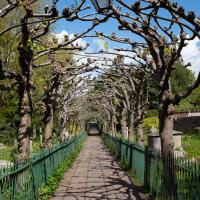Tagged: sky
Long Bemmie Wander with Lisa
11 Apr 2021
My friend Lisa joined me again, this time for a long wander through "Bemmie". In fact, I tweeted recently using "Bedmo" as my abbreviation for Bedminster, and apparently there's something of a culture war going on. From what I can glean, the longer-term residents call it "Bemmie" and consider "Bedmo" a name made up by hipster gentrifiers.
I had no idea, but then I didn't grow up around here, and I don't live in Bedminster, and I'm not a hipster. I'm not sure I've ever gentrified anywhere, either; Hotwells was already quite gentrified by the time I arrived. I probably just lowered the tone a bit.
Anyway. Lisa and I entered Bemmie by the traditional toll gate (though actually you'd only have paid if you were coming from the Long Ashton direction, not merely nipping across from Hotwells) and then almost literally combed the streets to knock several new roads off my list of targets. Along the way we saw lots of street art, as you'd expect, and admired the area's panoply of gorgeous knockers.
The reason Ashton Gate is called Ashon Gate is because it's the site of the former turnpike gate between Bristol and Ashton (now known as Long Ashton.) This is the actual toll house, still standing. "The Toll House closed in 1866 and was incorporated c1980 with Toll House Court", says the listing.
Toll House Court is now used by Second Step, a mental health charity, as part of their High Support Accommodation programme to combat homelessness.
The new development on the site of the old brewery (which I visited once for a behind-the-scenes peek with some food- and beer-blogger friends) isn't going down that well with the neighbours.
A piece by Dale Grimshaw. There's a great little piece on this here at Diff Graff, including some details of the migrating swarm of bees that interrupted the painting...
Work continues on the Six Sisters project, the "UK's largest female-led street art project".
Though actually this very end of it appears to be Fairfield Place, a tiny continuation of the road around the next corner. That's Gaywood House in the distance; we'll be visiting its very odd doctor's surgery in a bit...
Just to give an idea of prices, that two-bedroom house is currently on sale for £345,000. It looks in excellent condition.
Better Look at an Extension
14 Apr 2021
Apart from a lovely coffee and a slice of Victoria sponge from Twelve, there weren't any new sights on this little lunchtime jaunt except for a slightly better look at the long raised extension at the back of the St Vincent's Rocks Hotel, where I at least got to see the arches it's raised up on. I also got a fair bit of exercise by walking up the Zig Zag to get there, and saw far more people out than I have in months, what with the lockdown having just been significantly lifted. As I walked past The Mall pub they were turning people away from their already-full garden, and the (outdoor) cafe tables were pretty full up.
I'll know I'm fit—if it ever happens—when I can get up the Zig Zag without having to stop for a breather. In my defence, it is built up the side of a literal cliff.
I only found out that this was a raised extension when I read the listing after snapping the last photo. Today I ventured as close as I could and got to glimpse a bit of the rather nice support arches.
I'm guessing there used to be a grand front door, but then later the hotel annexed the building and didn't need it any more? But it's only surmise.
These aren't listed per se, but they're on the "local list" and named as 8-14 St Vincents Rocks, so I think that confirms that it used to be part of the hotel.
Nice to see someone keeping The Rocks Garage well-maintained. And they've safely wrapped Maggie Shapland's plaque in a carrier bag to protect it from paint drips, too. Excellent work.
Nice to see someone keeping The Rocks Garage well-maintained. And they've safely wrapped Maggie Shapland's plaque in a carrier bag to protect it from paint drips, too. Excellent work.
Desultory Coffee Wander
16 Apr 2021
Another day, another quick dash out for a coffee. I did at least try to take a different route from normal, especially on the way back, where I yet again got a bit lost in the strange paths, flyovers and underpasses that make up the odd maze of pedestrian "infrastructure" among the concrete jungle between the west of Greville Smyth and my neck of the woods in Hotwells. I swear one day I'll take a turn I've not tried before and end up being gored by a Bristolian minotaur.
Even on a quieter day, the roar of the traffic is pretty amazing. I was listening to a podcast about electric cars on noise-cancelling headphones, while wishing there were already a few more on the roads...
I think I should have gone back down into the park to come back up my normal path, that leads to a place where you can walk under the flyover and get back on the bridge to Hotwells. As it is I just tried heading north and ended up having to cross four lanes of busy traffic.
That seems to be the failure of the pedestrian paths around here: if you know where you're going really well, the best you can hope for is not to make a wrong turn, and then you can end up going all the way around the houses, including quite often back the way you came, and might manage to use some of the provided underpasses and crossings and avoid the most dangerous traffic. But if you don't know them like the back of your hand and just try heading for the place you want to get to, that you can actually see, you'll be led entirely astray and end up in a variety of dead-ends.
Man on a Mission
17 Apr 2021
I went rather outside my area today, as I went to pick something up from the Warhammer shop on Wine Street (Games Workshop as-was, and before that I think perhaps a rare retail outlet for Her Majesty's Stationery Office? I may be mis-remembering...) Anyway, a friend of mine wanted something picking up and posting to him, so I figured I'd knock some streets off my list along the way.
I first headed for the St George's Road area, walking down the narrow Brandon Steps and finding some strange wall art on Brandon Steep, then headed to the Old City via Zed Alley. The Warhammer shop visit was friendly and efficient, and, mission accomplished, I treated myself to a sausage roll and a flat white from Spicer + Cole, to take away and eat in Queen Square with its current decoration of hearts. I finished off with a detour up Park Street, looking out for St John's Conduit markers, before finally crossing Brandon Hill on the way home.
Quite a long wander, all told, and I'm a bit knackered today...
Who was it that decided that petrol stations had to be ugly? It's not like oil companies don't have money...
Rescued from dereliction by a project that added an extension for extra accommodation, turning it into a viable conversion to flats, apparently. The architects involved were Ferguson Mann, co-founded by George Ferguson, first person to serve in the capacity of Bristol's directly-elected mayor.
The Mall Gardens
19 Apr 2021
Just a quick errand to the Post Office to send off Mollog's Mob, but afterwards I bought a flat white and a new plant from Foliage Cafe and headed for The Mall Gardens to enjoy sitting in the sun and reading a book on the first day this year that's been properly warm enough for it. Nice.
The Mall Gardens does actually have some signs up letting people know it's a public garden, but I think it was only my researches for this project that brought the number of public gardens there are in Clifton to my attention, and reminded me that I could make use of this space in Clifton Village, a little closer to the coffee shops and a little more sheltered than Clifton Down.
Hard to capture how nice this big magnolia in the Cornwallis Crescent back garden is on camera.
With the neoclassical frontage of The Clifton Club (originally an assembly rooms) looking posh at the back.
I've been reading Adam Hall's books for many, many years. It's mostly his Quiller books, but I do have Bury Him Among Kings, about a World War I soldier, on my "incoming" shelf at the moment...
A New Wander, a New Cafe
21 Apr 2021
Obviously, I was trying to connect to the industrial history of the Canon's Marsh area, to the old gasworks, the docks railway, the warehouses they blew up to make way for all the rather soulless modern stuff (though I do like the Lloyds building, at least.) But what I mostly got out of today's walk is a new cafe to go to for my lunchtime outings. It's perhaps a little closer than both Imagine That and Hopper Coffee; not quite as close as Foliage and Twelve up in Clifton Village, but also not at the top of a steep hill.
No, not the mediocre Costa, but only a little way away from there: Rod and Ruby's, which opened in 2018 and which I've seen in passing several times but never popped into until today. What can I say? I was foolish. Great flat white, lovely interior, astoundingly good cannoli.
Sometimes you just have to get your head out of history and enjoy a pastry.
I know very little about the history of these buildings. There's a removals firm called Robinsons with some links to Bristol, and a building in Brimingham with an old sign saying "Robinsons Furniture Depositories", so I suppose it's possible this is a long-defunct furinture repository for a removals firm. Last planning application I can find is from 1998, before I even moved to Hotwells, granting permission to demolish "two storey office building and single storey store", which very much sounds like these two buildings.
The bit on the right still has a sign up saying it's Gnodal and Bioinduction—the firms whose car park is around the back—though Gnodal is defunct and Bioinduction sadly don't have any pictures from the Bristol office on the one-page website.
I really must poke my nose in and see if there's anything more than the apparently-tiny couryard back there.
I actually quite like this one, especially the pointed fronts of the living spaces. Decent size balconies, too.
Howard's Lock
27 Apr 2021
Bits of Entrance Lock have been coned off for ages, mostly the area with the lockkeepers' house on it. My friends Sarah and Vik mentioned at the weekend that it had recently been un-coned, so I wandered that way to cross the outermost lockgates for the first time this year. I don't know whether it's just my mood today or the weather, but it seemed a day for pushing a couple of photos in a more experimental direction in the post-processing...
The last time I noticed this antenna, I wondered if this was some radio amateur's shed. As soon as they renovated it and stuck the rather utilitarian metal doors on the front, I managed to place it: it's an electrical substation. A lot of the local ones seem to have antenna masts; I suppose it's how they do remote monitoring, or something. In my defence, I'm not sure the sign on the gate with the electricity symbol was there before, either.
Canons Marsh Coffee Trip
29 Apr 2021
Another quick excursion to Canon's Marsh, tempted back by Rod & Ruby's cannoli and flat white. This time I poked around some bits of the modern flats I'd not really experienced before, mused on the old gasworks, and headed back down the Hotwell Road, spotting a re-opening gallery and finishing off at the Adam & Eve, for which some locals are currently rushing to launch a bid to turn it into a community business rather than have a developer turn it into yet-more flats.
I was in a bouncy, positive mood, helped out by Life Without Buildings' Live at the Annandale Hotel album1. Note to self, though: the album is nearly an hour long, so if you hear the encore starting and you're still halfway down the Hotwell Road, you'll probably be late back from lunch...
1 That review's well worth a read. Music journalists tend to go extra-dreamy when trying to describe Sue Tompkins. See what I mean:
She circles her limber tongue-twisters, feints, and attacks from unexpected angles, dicing and rearranging them with the superhuman brio of an anime ninja and a telegraphic sense of lexical rhythm.
This is the stern of MV Balmoral, previously owned by P&A Campbell, the steamship operators, who I've mentioned once or twice before.
So new it doesn't seem to be on Google or Bing Maps yet, at least on the actual map bit, this is the one new build that stands alongside the two historic-building-conversion jobs (Purifier House and Engine House) at Brandon Yard, basically the site of the old gasworks.
They were one of the last sites to be regenerated, after some failed attempts to turn them into offices, including by the Soil Association. I don't know much about what they do in a gasworks, but I heard that the ground was highly polluted and needed a lot of remedial work before anything new could be put there.
Another of the old gasworks buildings (or at least the shell of it.) The modern flat conversion stands on Lime Kiln Road—before this site was flats, it was a gasworks, before it was gasworks it was a timber yard, and before it was a timber yard, starting in the 17th century, it was a lime kiln glassworks, demolished 1838.
I suppose it's possible that purifier house was the reason for the ground pollution I heard about that made the site hard to redevelop, but I'm only guessing, based on the idea that if you remove the impurities from the gas at your gasworks, you probably end up with a whole lot impure stuff you've got to put somewhere...
A mirrorball planetarium, an Augustinian cathedral, some underground car park vents, a roundabout, a casino and an exploratory science centre. It's a bit of a mix.
Leftovers with Lisa
01 May 2021
I didn't get to all the little leftover streets around the northeastern part of my area in today's wander, but I definitely knocked a few off the list, plus Lisa and I enjoyed the walk, and didn't get rained on too badly. We spotted the hotting-up of Wisteria season, checked out Birdcage Walk (both old and new), ventured onto the wrong side of the tracks1 and generally enjoyed the architecture.
1 Well, technically we probably shouldn't have been on the grounds of those retirement flats, but nobody started chasing us around the garden with a Zimmer frame
A peek through the building site railings at the back of Worcester House, the grand house at the end of Worcester Terrace.
The tiny stretch of Pembroke Road that I'd missed on previous excursion, once going to the left up Pembroke Vale, once to the right up Buckingham Vale.
Aforementioned pub. I've also visited in its former incarnation, Roo Bar, when it had an Australian theme.
These feel like retirement flats, so I guess the swing might be for younger visitors...
The places of worship are looking rather splendid in the sun today. The clock's right, too!
Alma Court, this time from my normal viewpoint, above the railway tracks on St John's Road.
Victoria Square Underpass
06 May 2021
I'm meant to be taking a little break from this project, but in my Victoria Square researches after my last walk I noticed a curiosity I wanted to investigate. The community layer on Know Your Place has a single photograph captioned, "The remains of an 'underpass' in Victoria Square".
Looking back through the maps, I could see that there really did used to be an underpass across what used to be Birdcage Walk. I can only guess that it was there to join the two halves of the square's private garden that used to be separated by tall railings that were taken away during WWII. Maybe it was a landscaping curiosity, maybe it was just to save them having to un-lock and re-lock two gates and risk mixing with the hoi polloi on the public path in the middle...
Anyway. Intrigued, I popped up to Clifton Village this lunchtime for a post-voting coffee, and on the way examined the remains of the underpass—still there, but only if you know what you're looking for, I'd say—and also visited a tiny little road with a cottage and a townhouse I'd never seen before, just off Clifton Hill, and got distracted by wandering the little garden with the war memorial in St Andrew's churchyard just because the gate happened to be open.
EDIT: Aha! Found this snippet when I was researching something completely different, of course. From the ever-helpful CHIS website:
When there were railings all round the garden and down the central path, in order that the children could play together in either garden there was a tunnel for them to go through. This was filled in during the 1970s but almost at the south east end of the path if one looks over the low wall the top of the arches can still be seen.
At some point, the local polling station stopped being at Holy Trinity and moved here.
Speaking of elections, one of the four elections happening today is the Bristol mayoral election; current enumbent Marvin Rees, an Evangelical of some variety, met church leaders here on the first day of his first term: “We prayed, and we invited the spirit of God into the city."
I wander on impulse down a little side-street I'd never really noticed before and find a curious cottage (Prospect Cottage, right) and a big 18th century listed house I've never seen before (Clifton Retreat, hidden behind the wisteria and other foliage ahead/left.)
If you'd shown me this photo before today, of a place I've been within spitting distance of thousands of times, I'd have not had a clue where it was. Bristol's fractal nature never ceases to amaze me.
And opposite Prospect Cottage, as if to give some direct contrast, the modern and anything-but-quaint goods entrance to the Nuffield Hospital.
I'm going to call this the memorial garden. Don't know if it has an official name, but it's a railinged-off area with the war memorial in it...
Up until WWII, anyway. The outline of the church remains around this square of land; the stones you can see bottom left are one of its walls. Among the many interesting images accompanying Bristol 24/7's story about the Bristol Blitz you can see an image of St Andrew's Church after the bombing raid of November 1940. I'd call it an interior shot, but most of the interior had become the exterior by that point...
